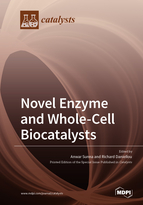Novel Enzyme and Whole-Cell Biocatalysts
A special issue of Catalysts (ISSN 2073-4344). This special issue belongs to the section "Biocatalysis".
Deadline for manuscript submissions: closed (31 January 2020) | Viewed by 84162
Special Issue Editors
Interests: biocatalysis; synthetic biology; bioengineering: proteins; nanoparticles
Special Issues, Collections and Topics in MDPI journals
Interests: biocatalysts; enzymology; glycobiochemistry; glycosyltransferases; glycosidases
Special Issues, Collections and Topics in MDPI journals
Special Issue Information
Dear Colleagues,
Global trends towards sustainability, the reduction of organic waste, and landfill avoidance are driving the demand for greener products with improved properties. Recent advances in synthetic biology, molecular biology, computational tools, and metabolic engineering have promoted the discovery of new enzymes and the rational design of whole-cell biocatalysts. Accordingly, with increased demand for sustainable and environmentally friendly biomanufacturing, the field of enzyme technology and biocatalysis (multi-enzymes and whole-cells) has become a primary focus for the synthesis of bio-based chemicals and high-value compounds.
In this Special Issue, we would like to highlight these current advances in the field of biocatalysis, with special emphasis on novel enzymes and whole-cell biocatalysts for applications in industry, health, or cosmetics.
Prof. Dr. Anwar Sunna
Prof. Dr. Richard Daniellou
Guest Editors
Manuscript Submission Information
Manuscripts should be submitted online at www.mdpi.com by registering and logging in to this website. Once you are registered, click here to go to the submission form. Manuscripts can be submitted until the deadline. All submissions that pass pre-check are peer-reviewed. Accepted papers will be published continuously in the journal (as soon as accepted) and will be listed together on the special issue website. Research articles, review articles as well as short communications are invited. For planned papers, a title and short abstract (about 100 words) can be sent to the Editorial Office for announcement on this website.
Submitted manuscripts should not have been published previously, nor be under consideration for publication elsewhere (except conference proceedings papers). All manuscripts are thoroughly refereed through a single-blind peer-review process. A guide for authors and other relevant information for submission of manuscripts is available on the Instructions for Authors page. Catalysts is an international peer-reviewed open access monthly journal published by MDPI.
Please visit the Instructions for Authors page before submitting a manuscript. The Article Processing Charge (APC) for publication in this open access journal is 2700 CHF (Swiss Francs). Submitted papers should be well formatted and use good English. Authors may use MDPI's English editing service prior to publication or during author revisions.
Keywords
- Chemo-enzymatic synthesis
- Glycosyl transferases
- Protein engineering
- Carbohydrates
- Biocatalysis
- Synthetic biology
- Industrial enzymes
- Thermostable enzymes
- Glycoside hydrolases
- Cell-free biocatalysis
- Natural and non-natural multi-enzyme pathways
- Bio-based chemicals







